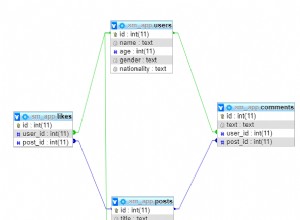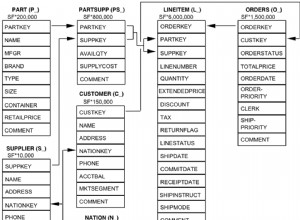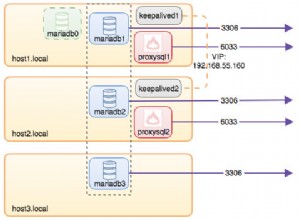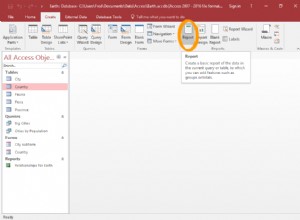La respuesta aceptada de usar un TVP es generalmente correcta, pero necesita algunas aclaraciones en función de la cantidad de datos que se pasan. Usar un DataTable está bien (sin mencionar que es rápido y fácil) para conjuntos de datos más pequeños, pero para conjuntos más grandes no no escala dado que duplica el conjunto de datos colocándolo en DataTable simplemente para pasarlo a SQL Server. Por lo tanto, para conjuntos de datos más grandes, existe la opción de transmitir el contenido de cualquier colección personalizada. El único requisito real es que debe definir la estructura en términos de tipos SqlDb e iterar a través de la colección, los cuales son pasos bastante triviales.
A continuación se muestra una descripción general simplista de la estructura mínima, que es una adaptación de la respuesta que publiqué en ¿Cómo puedo insertar 10 millones de registros en el menor tiempo posible? los datos no están actualmente en la memoria. Como puede ver en el código a continuación, esta configuración no es demasiado complicada, pero es muy flexible, eficiente y escalable.
Objeto SQL #1:Definir la estructura
-- First: You need a User-Defined Table Type
CREATE TYPE dbo.IDsAndOrderNumbers AS TABLE
(
ID NVARCHAR(4000) NOT NULL,
SortOrderNumber INT NOT NULL
);
GO
Objeto SQL # 2:Usa la estructura
-- Second: Use the UDTT as an input param to an import proc.
-- Hence "Tabled-Valued Parameter" (TVP)
CREATE PROCEDURE dbo.ImportData (
@ImportTable dbo.IDsAndOrderNumbers READONLY
)
AS
SET NOCOUNT ON;
-- maybe clear out the table first?
TRUNCATE TABLE SchemaName.TableName;
INSERT INTO SchemaName.TableName (ID, SortOrderNumber)
SELECT tmp.ID,
tmp.SortOrderNumber
FROM @ImportTable tmp;
-- OR --
some other T-SQL
-- optional return data
SELECT @NumUpdates AS [RowsUpdated],
@NumInserts AS [RowsInserted];
GO
Código C#, Parte 1:Definir el iterador/remitente
using System.Collections;
using System.Data;
using System.Data.SqlClient;
using System.IO;
using Microsoft.SqlServer.Server;
private static IEnumerable<SqlDataRecord> SendRows(Dictionary<string,int> RowData)
{
SqlMetaData[] _TvpSchema = new SqlMetaData[] {
new SqlMetaData("ID", SqlDbType.NVarChar, 4000),
new SqlMetaData("SortOrderNumber", SqlDbType.Int)
};
SqlDataRecord _DataRecord = new SqlDataRecord(_TvpSchema);
StreamReader _FileReader = null;
// read a row, send a row
foreach (KeyValuePair<string,int> _CurrentRow in RowData)
{
// You shouldn't need to call "_DataRecord = new SqlDataRecord" as
// SQL Server already received the row when "yield return" was called.
// Unlike BCP and BULK INSERT, you have the option here to create an
// object, do manipulation(s) / validation(s) on the object, then pass
// the object to the DB or discard via "continue" if invalid.
_DataRecord.SetString(0, _CurrentRow.ID);
_DataRecord.SetInt32(1, _CurrentRow.sortOrderNumber);
yield return _DataRecord;
}
}
Código C#, Parte 2:Usar el iterador/remitente
public static void LoadData(Dictionary<string,int> MyCollection)
{
SqlConnection _Connection = new SqlConnection("{connection string}");
SqlCommand _Command = new SqlCommand("ImportData", _Connection);
SqlDataReader _Reader = null; // only needed if getting data back from proc call
SqlParameter _TVParam = new SqlParameter();
_TVParam.ParameterName = "@ImportTable";
// _TVParam.TypeName = "IDsAndOrderNumbers"; //optional for CommandType.StoredProcedure
_TVParam.SqlDbType = SqlDbType.Structured;
_TVParam.Value = SendRows(MyCollection); // method return value is streamed data
_Command.Parameters.Add(_TVParam);
_Command.CommandType = CommandType.StoredProcedure;
try
{
_Connection.Open();
// Either send the data and move on with life:
_Command.ExecuteNonQuery();
// OR, to get data back from a SELECT or OUTPUT clause:
SqlDataReader _Reader = _Command.ExecuteReader();
{
Do something with _Reader: If using INSERT or MERGE in the Stored Proc, use an
OUTPUT clause to return INSERTED.[RowNum], INSERTED.[ID] (where [RowNum] is an
IDENTITY), then fill a new Dictionary<string, int>(ID, RowNumber) from
_Reader.GetString(0) and _Reader.GetInt32(1). Return that instead of void.
}
}
finally
{
_Reader.Dispose(); // optional; needed if getting data back from proc call
_Command.Dispose();
_Connection.Dispose();
}
}




